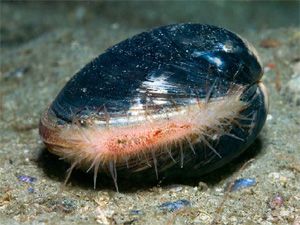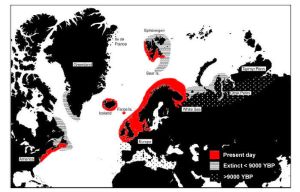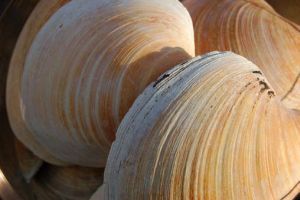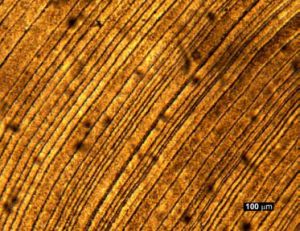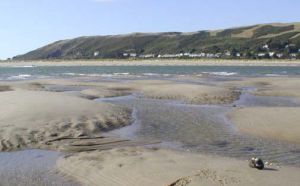|
Back in 2007, our research team based at the School of Ocean Sciences in Bangor University gained quite a bit of mollusc-related publicity as a result of the discovery of the longest-lived non-colonial animal known to science, a specimen of the marine bivalve Arctica islandica that had lived, remarkably, for just over 400 years. Full page spreads appeared in the Sunday Times and the Daily Mail, and our research even made it into Time magazine’s Top Ten Scientific Discoveries of that year. As result, Conch Soc was kind enough to ask me to deliver a talk at its subsequent AGM at the Natural History Museum, and some of you may remember me waffling on about how we could look at the annual growth lines in the shell and use them to give us an insight into marine environments of the past. Last year, we achieved more exposure with an exhibit at the Royal Society’s 350th anniversary Summer Science Exhibition, held at the Southbank Centre. The strapline, once again, was longevity based: “Arctica islandica, the longest-lived animal on Earth”, although by this time, after more research, the lifetime of the world’s longest-lived animal had increased somewhat and now stood at 507 years. Distribution A. islandica is a burrowing (figure 5) infaunal clam, widely distributed around the North Atlantic shelf seas (figure 2). It is most common off the North American coast between Cape Hatteras and Newfoundland, around Iceland, and on the NW European shelf between the UK and northern Norway. Its southern range limit off Europe is currently in the North Sea and Irish Sea but this may be moving northwards as a result of warming oceans. For the same reason its northern range limit may now extend as far as Svalbard. Its preferred habitat is sandy mud, although around Iceland it lives almost everywhere in a wide range of soft sediments. A. islandica is found at depths ranging from the shallow subtidal zone to 200m. Longevity The longevity of A. islandica is high throughout its range, but the most long-lived shells that we have found come from animals living off the north coast of Iceland close to the island of Grimsey. We have collected and aged several specimens from this site with lifetimes in excess of 300 years. It is one of these specimens that is, at 507 years, the longest-lived non-colonial animal whose precise age has been determined. A. islandica from other regions tend not to live quite as long as that, and the oldest individuals from the North American coast, the Irish Sea and the North Sea ‘only’ reach around 250 years. Archives of the environment. If we are to respond appropriately to the potential risks posed by climate change, we need to be able to distinguish between the fingerprint of human activities and the natural background. This requires access to detailed data about the environment going back through the period (the last few hundred years) of increasing human impact. The problem is that instrumental measurements go back only about 200 years at most and are in any case spatially sparse. So we have to augment the instrumental data with so-called ‘proxy’ data – this just means data extracted from natural archives such as tree-rings, ice cores and corals and interpreted in terms of some local environmental variable, for example temperature. But sources of proxy data also have their limitations. Tree-rings and ice cores record only terrestrial conditions and corals, while they do record the marine environment, are restricted to the tropical latitudes. There are other marine archives derived from sediment cores, but these cannot usually be dated with any great precision or accuracy. This leaves a significant gap in our understanding of the climate system because some of the key components of the global ocean circulation – especially the heat- and salinity-driven overturning which plays a crucial role in the global distribution of heat energy – actually take place in parts of the ocean that are well outside the tropics, including parts of the northern North Atlantic Ocean. What has been missing up until now is a precisely dated, high-resolution archive for the non-tropical marine environment. This is where A. islandica comes into the picture. I’ve already described how this species is common in the shelf seas around the North Atlantic Ocean. But it’s the fact that we can build an absolutely dated chronology using its shell that makes it supremely useful as a natural archive. Shell growth in A. islandica is characterized by a short period every year (probably in late summer or autumn) when deposition becomes very slow or ceases altogether. These periods can be seen as distinct bands on the outside of the shell (figure 3). When we look at the growth patterns internally, under a microscope, they show up as darker lines (figure 4). We can record the amount of growth during the year by measuring the distance between these darker lines. We can also find how long the animal lived by counting the increments between the lines and, as long as we know the year when the animal died, we can work out the exact calendar year when each increment was deposited. That’s not all, however. When we compare the patterns of increment widths from several animals that were living in the same part of the sea bed, we find that they were all growing in the same way. In a good year, they all deposit a lot of shell (thick growth increments) and in a bad year they all produce thin increments. That’s useful because it shows that they were all responding to the same environmental factors, so just by looking at the growth patterns we can say something about the common environment of all the shells. What’s more, the fact that each population shows this synchronized growth means that we can extend our archive back in time. We can take any dead shell we happen to find on the sea bed and see if its growth patterns are similar to the patterns in shells from living animals. If they are, we can work out the dates when the dead shell was being deposited (this technique is derived from tree-ring research and is called ‘crossdating’), and then we can use the growth patterns in the dead shells to study marine climate during periods before any of the living clams were alive. There’s one other key characteristic of A. islandica that helps us look at past climates, and that is its remarkable lifespan. If a species only lived for a few years or a few decades, we would have to measure, analyse and crossdate an enormous number of shells to extend our dated archive (called a ‘chronology’) very far back in time. But because single individuals can continue to produce shell for centuries, we can crossdate back in time using relatively few shells. The longest crossdated chronology we have built so far uses A. islandica from north of Iceland and goes back 1,350 years. What can Arctica tell us? Just knowing the year when shell was deposited is not very informative by itself. But there are a number of characteristics of the shell that enable us to say something specific about the environment in which the shell was deposited. First, the width of the growth increments is a simple indication of how much shell material the animal was able to produce in a single year. In most cases this is likely related to food supply, but it may also record other factors, such as seawater temperature or the presence of ice at the sea surface, especially in regions where the animal is stressed by that factor. Another approach is to look at the composition of the shell material itself. The different isotopes of oxygen and carbon can be measured with great precision and these analyses can tell us about seawater temperature and salinity at the time of shell deposition. They can also help us investigate more complex aspects, such as changes through time in the original source of local water masses, or the uptake of fossil fuel carbon from the atmosphere into the marine environment. Finally, the concentrations of other elements in the shell (calcium, strontium, magnesium, boron, zinc and many others) can be measured and compared, and these analyses can be used to investigate, for example, marine pollution and ocean acidification. How far back can we go? The Iceland chronology goes back 1,350 years, and we have also created one for the Irish Sea with a length of nearly 500 years. The ability to extend them even further depends on the availability of older shell material, which in turn depends on the persistence of the population and the fate of the dead shells. A. islandica has been common in the shelf seas surrounding the North Atlantic ocean at least since the last glaciation (about 18,000 years), but it would be difficult to find shells from any single population to cover that whole period. More likely, a network of so-called ‘floating chronologies’ (made up of shells with growth patterns which match each other but which cannot be linked to any livecollected shells) will be built up with the potential to be connected and correctly dated as more material comes to light. Ageing research There is one other strand of research into A. islandica that we are involved with, and that is the question of exactly why and how these clams have evolved to be so long-lived. They appear to be able to switch off some of the usual processes of ageing (such as deterioration in muscle tissue and propensity to tumours), and it has been suggested that if they weren’t eaten by predators they could in principle live for ever. Laboratory research into the ageing process tends to focus on short-lived model species because they are easy to rear and study in the laboratory. The obvious problem with these species is that they lack the very trait that is of interest – the propensity to live long and healthy lives. If we can identify the mechanisms that delay or halt the ageing process in A. islandica it would be possible to target research using the traditional model species, directing it towards the most productive areas. What about other species? While many marine molluscs have annual growth bands, A. islandica is far and away the most useful for building long chronologies, simply because of its great longevity. However, we have recently been looking at other species, including Glossus humanus and Glycymeris glycymeris and have found that both these species can be crossdated. G. glycymeris in particular has a lot of potential, since it seems to live longer than previously thought (up to 200 years), and it may in some ways be an even more sensitive climate indicator than A. islandica. Where can I find it? A. islandica shells are commonly found on beaches around the UK, especially around North to Mid Wales (figure 6), the north and east coasts of Ireland and the west coast of Scotland. You may very occasionally find them washed ashore alive, especially after heavy storms. Please don’t hesitate to get in touch to tell us about any unusual Arctica finds! Where can I find out more? You can keep up to date with our latest research on our website: http://www.sos.bangor.ac.uk/sclero. Alternatively, you can e-mail us at sclero@bangor.ac.uk or call us at 01248 382853. References 1 http://www.paulkayphotography.co.uk 2Dahlgren, T.G., Weinberg, J.R., Halanych, K.M., 2000. Phylogeography of the ocean quahog (Arctica islandica): influences of paleoclimate on genetic diversity and species range. Marine Biology 137 (3), 487-495. |
figure 1: Live A. islandica on the sea bed in a Scottish loch (Photo: Paul Kay1)
figure 2: Present day distribution of Arctica islandica shown in red (image adapted from Dahlgren et al 20002)
figure 3: Arctica islandica shells showing distinctive annual banding.
figure 4: Internal growth patterns in A. islandica.
figure 5: A. islandica in its infaunal setting with closed (above) and open siphons (below). (Photos: Martin Sayer)
figure 6: Arctica shell on the beach at Borth, Cardigan Bay.
|
Arctica islandica, the longest-lived animal on Earth
Issue
25
Page
3
Species

